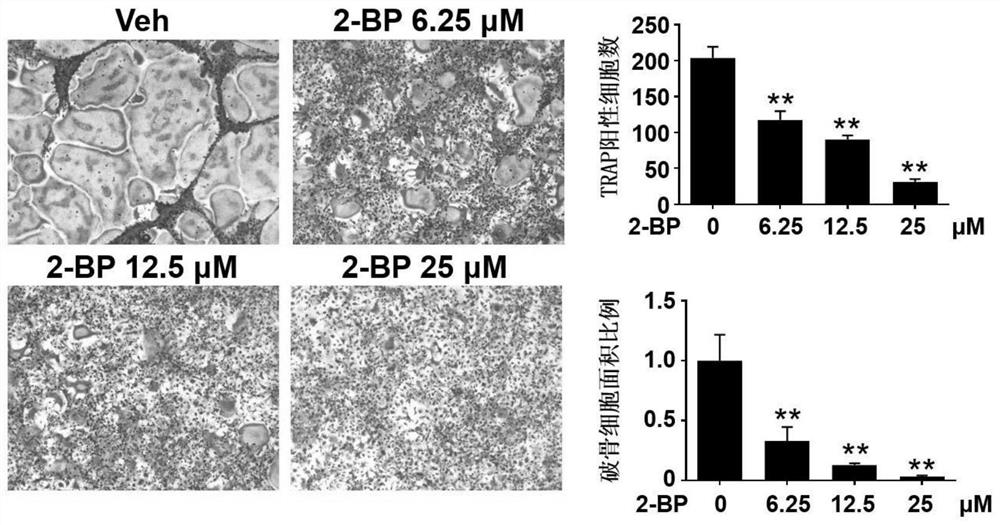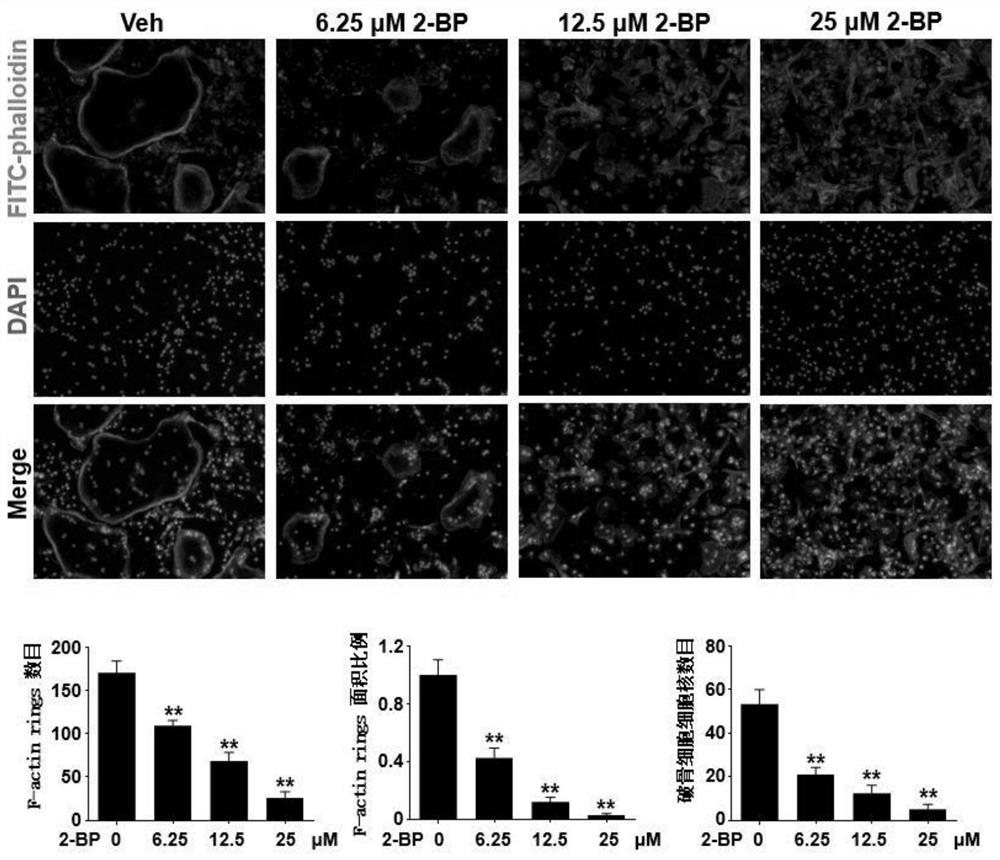Application of 2-bromopalmitate in preparation of drugs for prevention and treatment of bone loss related diseases
A bromopalmitic acid, bone loss technology, applied in the field of medicine, can solve the problems of kidney toxicity, mandibular osteonecrosis, transient "flu-like" symptoms, etc.
- Summary
- Abstract
- Description
- Claims
- Application Information
AI Technical Summary
Problems solved by technology
Method used
Image
Examples
Embodiment 1
[0023] Example 1: 2--BP inhibits osteoclast differentiation without significant cytotoxicity
[0024] (1) Isolation and culture of primary bone marrow-derived monocyte-macrophage BMMs
[0025] Take a C57BL / 6 mouse aged 5 to 8 weeks, put it to death by pulling its neck, soak it in 75% medical alcohol for 3 minutes, dissect the lower limbs of the mouse in a clean workbench, separate the skin, fascia, and knee and hip joint capsules, The mouse femur and tibia were obtained and placed in a bacterial culture dish previously added with sterilized phosphate-buffered saline. Use sterile scissors to cut the upper end of the femur and the lower end of the tibia, separate the bone marrow by centrifugation at 10,000 rpm, add 2ml of red blood cell lysate to resuspend the bone marrow, and let stand for 5 minutes to lyse the red blood cells. Then centrifuge horizontally at room temperature (1000rpm, 5 minutes), discard the liquid, add 10ml of complete Alpha MEM culture solution containing 3...
Embodiment 2
[0034] Example 2: 2-BP inhibits the expression of related characteristic genes in the process of osteoclast differentiation
[0035] (1) Cell treatment and RNA collection and separation
[0036] A control group and 3 drug-treated groups were set up, with 3 replicate wells in each group, and mononuclear macrophages were planted in a 6-well plate (40×10 4 cells / well), the next day, the culture medium was replaced with complete Alpha MEM medium containing 50ng / ml RANKL and 30ng / ml M-CSF, and 6.25, 12.5, 25μM 2-BP were added to the drug treatment group, and the control group Add the same amount of dimethyl sulfoxide solvent as the 25 μM 2-BP group, change the medium every other day, culture for 6 days, and terminate when the control group has obviously mature and hypertrophic osteoclasts. Use the RNA extraction kit to extract the total RNA, after measuring the concentration, take 500ng RNA reaction system to synthesize cDNA. The reaction system includes reverse transcription buf...
Embodiment 3
[0039] Example 3: 2-BP inhibits the expression of important transcription factors NFATc1 and c-Fos downstream of the signaling pathway during osteoclast differentiation
[0040] (1)Protein sample processing and extraction
[0041] Mononuclear macrophages were seeded in 6-well plates (40 × 10 4 Cells / well, 30ng / ml M-CSF complete Alpha MEM culture medium), divided into control group and drug treatment group, after overnight, the medium was replaced with 50ng / ml RANKL, 30ng / ml M-CSF complete Alpha MEM culture solution, and 25 μM 2-BP was added to the drug treatment group, and the same amount of dimethyl sulfoxide solvent was added to the control group, the solution was changed every other day, and protein samples were collected on days 0, 1, 3, and 5, respectively.
[0042] Protein sample extraction and concentration determination: After culturing to the corresponding time point, quickly discard the supernatant, wash once with phosphate-buffered saline at 4°C, place the 6-well p...
PUM
 Login to View More
Login to View More Abstract
Description
Claims
Application Information
 Login to View More
Login to View More - R&D
- Intellectual Property
- Life Sciences
- Materials
- Tech Scout
- Unparalleled Data Quality
- Higher Quality Content
- 60% Fewer Hallucinations
Browse by: Latest US Patents, China's latest patents, Technical Efficacy Thesaurus, Application Domain, Technology Topic, Popular Technical Reports.
© 2025 PatSnap. All rights reserved.Legal|Privacy policy|Modern Slavery Act Transparency Statement|Sitemap|About US| Contact US: help@patsnap.com



